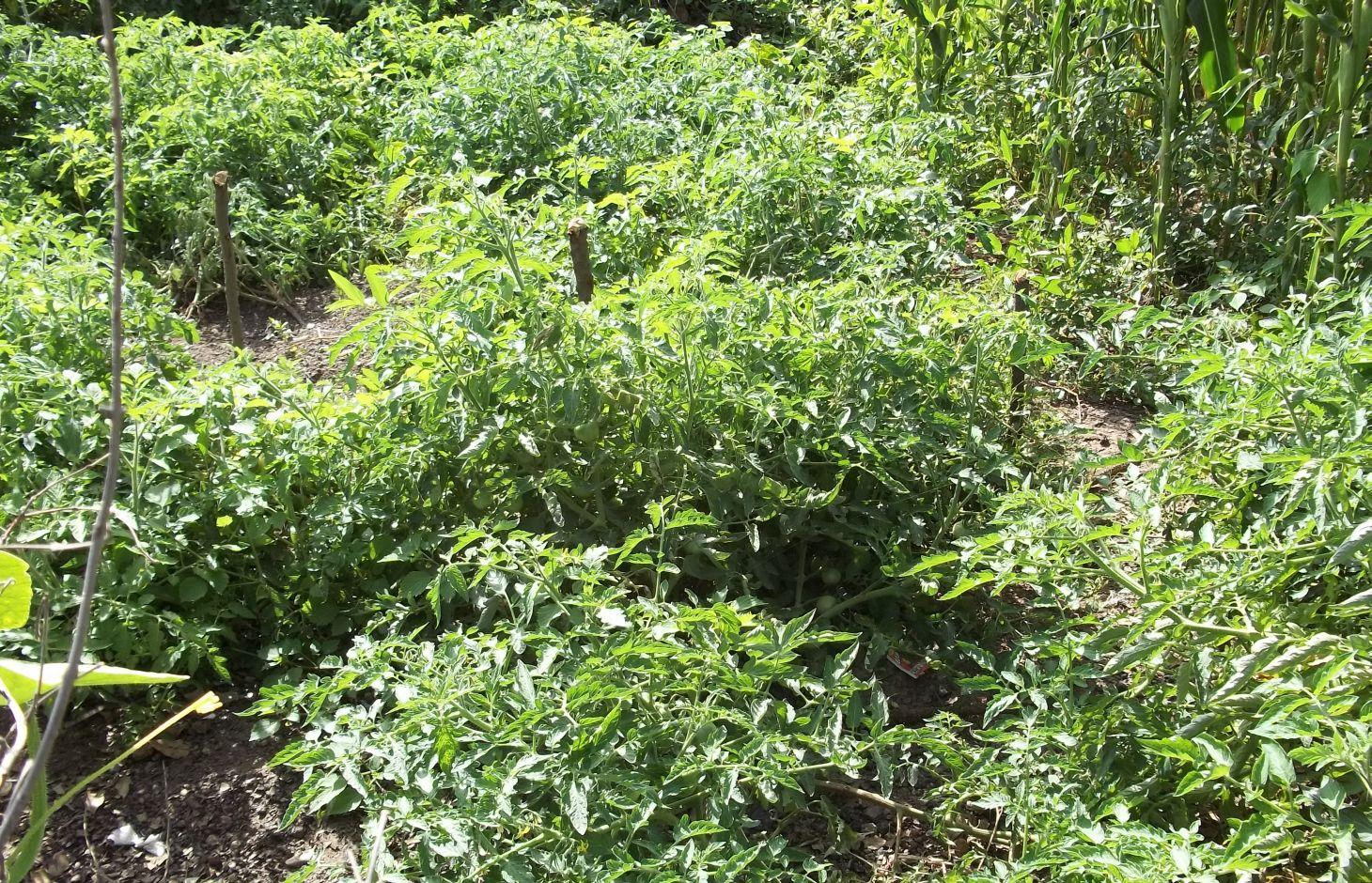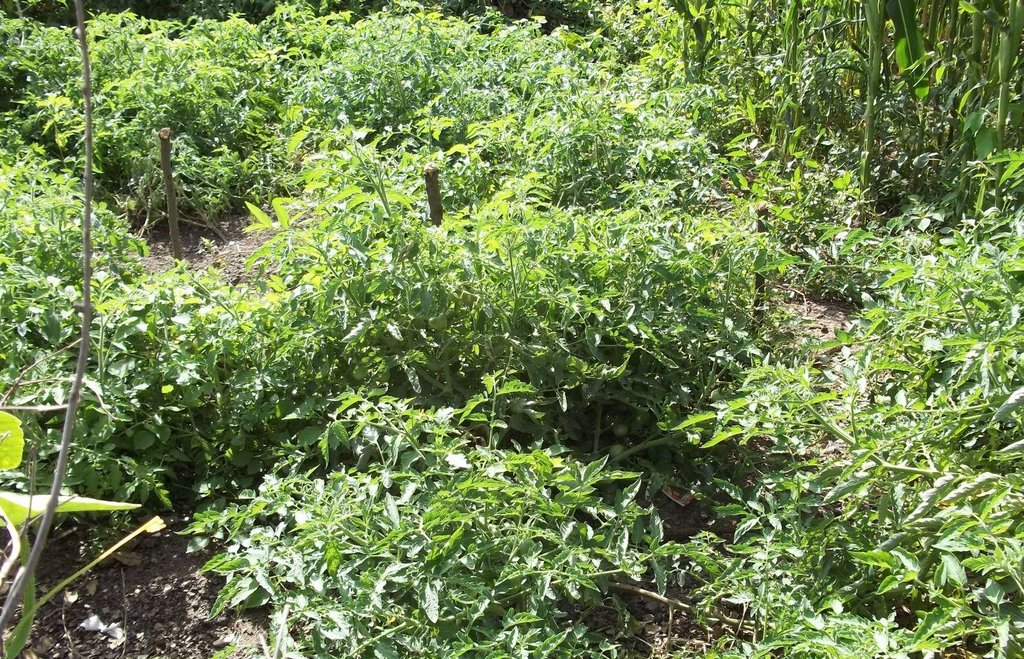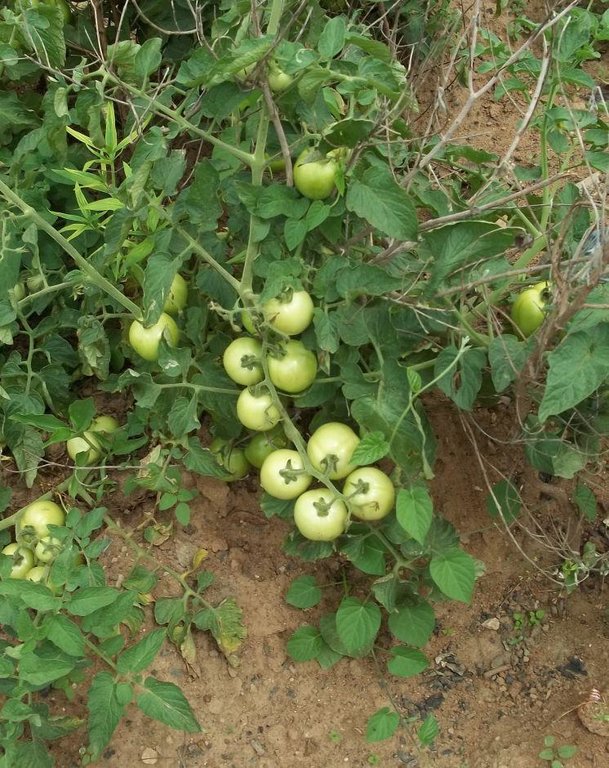Introducing tomato varieties using succession planting [Mali]
- Criação:
- Atualização:
- Compilador/a: Dieter Nill
- Editor: –
- Revisor: Deborah Niggli
Introduction des variétés de tomates d’un cycle cultural échelonné (French)
technologies_1636 - Mali
Veja as seções
Expandir tudo Recolher tudo1. Informação geral
1.2 Detalhes do contato das pessoas capacitadas e instituições envolvidas na avaliação e documentação da tecnologia
Especialista em GST:
Dako Jean Parfait
parfaitdako@yahoo.fr
National Directorate of Agriculture
Mali
Nome do projeto que facilitou a documentação/avaliação da Tecnologia (se relevante)
Manual of Good Practices in Small Scale Irrigation in the Sahel (GIZ )Nome da(s) instituição(ões) que facilitou(ram) a documentação/ avaliação da Tecnologia (se relevante)
Deutsche Gesellschaft für Internationale Zusammenarbeit (GIZ) GmbH (GIZ) - Alemanha1.3 Condições em relação ao uso da informação documentada através de WOCAT
Quando os dados foram compilados (no campo)?
01/07/2012
O/a compilador/a e a(s) pessoa(s) capacitada(s) aceitam as condições relativas ao uso de dados documentados através da WOCAT:
Sim
1.4 Declaração de sustentabilidade da tecnologia descrita
A tecnologia descrita aqui é problemática em relação a degradação da terra de forma que não pode ser declarada uma tecnologia de gestão sustentável de terra?
Não
2. Descrição da tecnologia de GST
2.1 Descrição curta da tecnologia
Definição da tecnologia:
Increasing the revenues of growers through the production of off-season tomatoes
2.2 Descrição detalhada da tecnologia
Descrição:
Tomato production in the off-season is restricted by the prevalence of insects and disease at that time. To mitigate these difficulties, it is important to find sustainable, non-polluting solutions that are accessible to producers. These solutions are: good tomato growing practices, the use of resilient and suitable tomato varieties, and biological control. Some varieties of off-season tomatoes have produced well and shown a certain resilience to diseases and other pests (nematodes and aphids). Growing tomatoes off season also means the market can be supplied when such produce is lacking.
The specific objectives of growing off-season tomatoes are: promoting market garden production during the off-season; reducing the scarcity of tomatoes in the off-season; increasing the revenues of growers. The average yield obtained from each crop is around 15,500 kilograms per ha, with yields peaking at 35,500 kilograms per ha in some places.
Implementation: 1) Select a site for the nursery that is near to a water source. Clean and turn the soil in the plot. The insects and weeds in the soil often pass on disease to young nursery plants. It is therefore necessary to disinfect the soil. Manure must be worked into the soil or compost prior to disinfection. In the week prior to treatment, the nursery soil must be kept sufficiently moist. Growers can disinfect their soil with fire, hot water, or chemical products. 2) The way a bed is prepared depends on the season. In the dry season, the nursery bed is sunk into the ground so that it holds water better. In the rainy season, the nursery bed is raised (mounded) to prevent waterlogging and promote good drainage once the rains have abated. 3) Seed requirement: Two to three grams for each 100-square-metre plot. Fresh market tomatoes: 300 grams per hectare. Industrial tomatoes: 400 grams per hectare. 4) Fertilisers are optional. During sowing, they can be applied in small quantities in soluble form. Alternatively, three kg of well-rotted manure can be applied per square metre. 5) Protecting plants: Combat leafminers and prevent damping off by applying authorised plant health products. Cover the nursery with a mosquito net until the seedlings are planted out. 6) Seedbeds are laid out in rows 15 to 20 centimetres apart. The seeds are sown along one-centimetre-deep furrows or simply scattered. Seed density should be 100 per linear metre, i.e. 500 per square metre. The seeds are then covered with earth or fine sand. The beds are covered with straw, which is removed as soon as the seedlings sprout. Duration of nursery stage: three to four weeks. 7) Healthy and strong plants with at least six proper leaves are planted out. The distance required between plants varies according to the season, growing conditions and varieties in question: 80 x 60 cm; 80 x 40 cm; 60 x 60 cm; 60 x 40 cm. When transplanting plants, compact the earth around the roots. Each plant must be carefully extracted along with the clump of earth its roots are embedded in. Dig a hole in the bed and insert the plant. Plants are planted in raised beds or mounds in the rainy season and in the beds or flat ploughed ground outside of the rainy season. Transplanting should be carried out at the end of the day, when it is cooler. Water plants immediately after planting them out. Whatever the growing season, it is best to cover young, freshly transplanted plants with a straw cover providing adequate shade. If some plants die, replace them with others held in the nursery. 8) How to prune tomato plants: Remove buds growing between the leaf and the stalk. Retain only one or two thick stalks with their leaves and their flowers. Pruning should be carried out once or twice a month. Prune tomato plants whose fruit will be used for industrial purposes or canned (determinate tomatoes may not be pruned). From time to time, remove suckers (a side shoot from an axillary bud) when weeding and hoeing. For fast-growing varieties, retain just one thick stalk. 9) The quantities of chemical fertiliser to apply vary as follows: 40 to 120 kilograms of nitrogen per ha, 30 to 90 kilograms of phosphate per ha, and 30 to 90 kilograms of potash per ha. Never spray fertilisers on young or wet plants as this will burn them. An alternative is 20 to 30 tonnes of organic fertiliser per ha 10) Plant care: Plants must be watered regularly (morning and evening), particularly during fruit formation. The water quantities are then reduced towards the end of the growing cycle. Weed and hoe regularly, especially in the early stages of planting. Stake the tomato cultivars before they begin forming fruit. This will stop the fruits touching the ground. Using mulch provides better quality fruit.
2.3 Fotos da tecnologia
2.5 País/região/locais onde a tecnologia foi aplicada e que estão cobertos nesta avaliação
País:
Mali
Região/Estado/Província:
Mali
Especificação adicional de localização:
Kayes, Koulikoro, Sikasso, Ségou, Mopti, Bamako
2.6 Data da implementação
Caso o ano exato seja desconhecido, indique a data aproximada:
- menos de 10 anos atrás (recentemente)
2.7 Introdução da tecnologia
Especifique como a tecnologia foi introduzida:
- através de projetos/intervenções externas
Comentários (tipos de projeto, etc.):
Ongoing for three years
3. Classificação da tecnologia de GST
3.1 Principal/principais finalidade(s) da tecnologia
- Melhora a produção
3.2 Tipo(s) atualizado(s) de uso da terra onde a tecnologia foi aplicada

Terra de cultivo
- Cultura anual
Comentários:
Major land use problems (compiler’s opinion): Tomato production in the off-season is restricted by the prevalence of insects and disease at that time, scarcity of tomatoes in the off-season
3.3 Mais informações sobre o uso da terra
Abastecimento de água para a terra na qual a tecnologia é aplicada:
- Misto de precipitação natural-irrigado
Número de estações de cultivo por ano:
- 1
Especifique:
Longest growing period in days: 120; Longest growing period from month to month: August-November
3.4 Grupo de GST ao qual pertence a tecnologia
- Gestão integrada de pragas e doenças (inclusive agricultura orgânica)
3.5 Difusão da tecnologia
Comentários:
Total area covered by the SLM Technology is 0.75 m2.
The succession planting programme for the 2010/11 and 2011/12 growing seasons covered a total of 40 circles in six regions (Kayes, Koulikoro, Sikasso, Ségou and Mopti and Bamako District). Farming advisors cascaded training to 1,200 producers who own succession-planted plots. Each succession plot is 400 square metres in size. In total, 75 hectares have been sown by producers.
3.6 Medidas de GST contendo a tecnologia

Medidas vegetativas
- V1: cobertura de árvores/arbustos
Comentários:
Type of vegetative measures: scattered / dispersed
3.7 Principais tipos de degradação da terra abordados pela tecnologia

Degradação biológica
- Bp: aumento de pragas/doenças, perda de predadores
Comentários:
Main causes of degradation: other natural causes (avalanches, volcanic eruptions, mud flows, highly susceptible natural resources, extreme topography, etc.) specify (insects and diseases)
3.8 Redução, prevenção ou recuperação da degradação do solo
Especifique o objetivo da tecnologia em relação a degradação da terra:
- Reduzir a degradação do solo
4. Especificações técnicas, implementação de atividades, entradas e custos
4.1 Desenho técnico da tecnologia
4.2 Especificações técnicas/ explicações do desenho técnico
Raised bed (15 to 20 centimetres high). In the rainy season, the nursery bed is raised (mounded) to prevent waterlogging and promote good drainage once the rains have abated. In the dry season, the nursery bed is sunk into the ground so that it holds water better.
Technical knowledge required for field staff / advisors: high
Technical knowledge required for land users: low
Main technical functions: promotion of vegetation species and varieties (quality, eg palatable fodder), use of resilient and suitable tomato varieties
Scattered / dispersed
Vegetative material: F : fruit trees / shrubs
4.4 Atividades de implantação
| Atividade | Tipo de medida | Periodicidade | |
|---|---|---|---|
| 1. | Select a site for the nursery that is near to a water source | Vegetativo | |
| 2. | disinfect the soil | Vegetativo | |
| 3. | sowing of seeds | Vegetativo | |
| 4. | Fertilisers are optional. During sowing, they can be applied in small quantities in soluble form | Vegetativo | |
| 5. | Cover the nursery with a mosquito net until the seedlings are planted out | Vegetativo |
4.6 Atividades recorrentes/manutenção
| Atividade | Tipo de medida | Periodicidade/frequência | |
|---|---|---|---|
| 1. | Healthy and strong plants with at least six proper leaves are planted out | Vegetativo | |
| 2. | When transplanting plants, compact the earth around the roots. Each plant must be carefully extracted along with the clump of earth its roots are embedded in | Vegetativo | |
| 3. | Dig a hole in the bed and insert the plant. | Vegetativo | |
| 4. | Water plants immediately after planting them out | Vegetativo | |
| 5. | cover young, freshly transplanted plants with a straw cover providing adequate shade. | Vegetativo | |
| 6. | If some plants die, replace them with others held in the nursery | Vegetativo | |
| 7. | prune tomato plants | Vegetativo | |
| 8. | Plants must be watered regularly (morning and evening), particularly during fruit formation. | Vegetativo | |
| 9. | Weed and hoe regularly, especially in the early stages of planting. Stake the tomato cultivars before they begin forming fruit | Vegetativo |
4.8 Fatores mais importantes que afetam os custos
Descreva os fatores mais determinantes que afetam os custos:
Economic analysis of off-season tomato production from 2012 to 2013:
Total area sown with off-season tomato: 175 hectares
Quantity of off-season tomatoes grown: 4,300 tonnes
Price of tomatoes grown in season: 170 to 200 CFA francs per kilogram
Price of tomatoes grown off season: 600 to 800 CFA francs per kilogram
Each grower produces an average 650 kilograms on a succession plot, with some producing up to 1,400 kilograms. Produce from the plots has earned growers between 300,000 and 630,000 CFA francs (gross) over the winter season, with 75% of production sold at 600 CFA francs per kilogram.
5. Ambiente natural e humano
5.1 Clima
Precipitação pluviométrica anual
- <250 mm
- 251-500 mm
- 501-750 mm
- 751-1.000 mm
- 1.001-1.500 mm
- 1.501-2.000 mm
- 2.001-3.000 mm
- 3.001-4.000 mm
- > 4.000 mm
Zona agroclimática
- Semiárido
Thermal climate class: tropics
5.2 Topografia
Declividade média:
- Plano (0-2%)
- Suave ondulado (3-5%)
- Ondulado (6-10%)
- Moderadamente ondulado (11-15%)
- Forte ondulado (16-30%)
- Montanhoso (31-60%)
- Escarpado (>60%)
Formas de relevo:
- Planalto/planície
- Cumes
- Encosta de serra
- Encosta de morro
- Sopés
- Fundos de vale
Zona de altitude:
- 0-100 m s.n.m.
- 101-500 m s.n.m.
- 501-1.000 m s.n.m.
- 1.001-1.500 m s.n.m.
- 1.501-2.000 m s.n.m.
- 2.001-2.500 m s.n.m.
- 2.501-3.000 m s.n.m.
- 3.001-4.000 m s.n.m.
- > 4.000 m s.n.m.
5.3 Solos
Profundidade do solo em média:
- Muito raso (0-20 cm)
- Raso (21-50 cm)
- Moderadamente profundo (51-80 cm)
- Profundo (81-120 cm)
- Muito profundo (>120 cm)
Textura do solo (solo superficial):
- Médio (limoso, siltoso)
- Fino/pesado (argila)
Matéria orgânica do solo superficial:
- Médio (1-3%)
- Baixo (<1%)
5.4 Disponibilidade e qualidade de água
Lençol freático:
5-50 m
Disponibilidade de água de superfície:
Médio
Qualidade da água (não tratada):
apenas para uso agrícola (irrigação)
5.5 Biodiversidade
Diversidade de espécies:
- Médio
5.6 Características dos usuários da terra que utilizam a tecnologia
Orientação de mercado do sistema de produção:
- Misto (subsistência/comercial)
Rendimento não agrícola:
- 10-50% de toda renda
Nível relativo de riqueza:
- Pobre
- Média
Nível de mecanização:
- Trabalho manual
Gênero:
- Homens
Indique outras características relevantes dos usuários da terra:
Population density: < 10 persons/km2
Annual population growth: 2% - 3%
10% of the land users are rich.
50% of the land users are average wealthy.
30% of the land users are poor.
10% of the land users are very poor.
5.7 Média da área de terra própria ou arrendada por usuários da terra que utilizam a tecnologia
- < 0,5 ha
- 0,5-1 ha
- 1-2 ha
- 2-5 ha
- 5-15 ha
- 15-50 ha
- 50-100 ha
- 100-500 ha
- 500-1.000 ha
- 1.000-10.000 ha
- > 10.000 ha
É considerado pequena, média ou grande escala (referente ao contexto local)?
- Pequena escala
5.8 Propriedade de terra, direitos de uso da terra e de uso da água
Comentários:
The irrigated land is allocated by the chief
5.9 Acesso a serviços e infraestrutura
Saúde:
- Pobre
- Moderado
- Bom
Educação:
- Pobre
- Moderado
- Bom
Assistência técnica:
- Pobre
- Moderado
- Bom
Emprego (p. ex. não agrícola):
- Pobre
- Moderado
- Bom
Mercados:
- Pobre
- Moderado
- Bom
Energia:
- Pobre
- Moderado
- Bom
Vias e transporte:
- Pobre
- Moderado
- Bom
Água potável e saneamento:
- Pobre
- Moderado
- Bom
Serviços financeiros:
- Pobre
- Moderado
- Bom
6. Impactos e declarações finais
6.1 Impactos no local mostrados pela tecnologia
Impactos socioeconômicos
Renda e custos
Rendimento agrícola
Impactos socioculturais
Segurança alimentar/auto-suficiência
Atenuação de conflitos
contribution to human well-being
Comentários/especificar:
Some varieties of off-season tomatoes have produced well and shown a certain resilience to diseases and other pests (nematodes and aphids). Growing tomatoes off season also means the market can be supplied when such produce is lacking. The average yield obtained from each crop is around 15,500 kilograms per ha, with yields peaking at 35,500 kilograms per ha in some places.
Impactos ecológicos
Solo
Cobertura do solo
Biodiversidade: vegetação, animais
Biomassa/carbono acima do solo
Diversidade vegetal
Controle de praga/doença
6.3 Exposição e sensibilidade da tecnologia às mudanças climáticas graduais e extremos/desastres relacionados ao clima (conforme o ponto de vista dos usuários da terra)
Mudança climática gradual
Mudança climática gradual
| Estação do ano | Tipo de mudança climática/extremo | Como a tecnologia lida com isso? | |
|---|---|---|---|
| Temperatura anual | aumento | bem |
Extremos (desastres) relacionados ao clima
Desastres meteorológicos
| Como a tecnologia lida com isso? | |
|---|---|
| Temporal local | bem |
| Tempestade de vento local | bem |
Desastres climatológicos
| Como a tecnologia lida com isso? | |
|---|---|
| Seca | bem |
Desastres hidrológicos
| Como a tecnologia lida com isso? | |
|---|---|
| Inundação geral (rio) | bem |
Outras consequências relacionadas ao clima
Outras consequências relacionadas ao clima
| Como a tecnologia lida com isso? | |
|---|---|
| Período de crescimento reduzido | bem |
6.4 Análise do custo-benefício
Como os benefícios se comparam aos custos de implantação (do ponto de vista dos usuários da terra)?
Retornos a curto prazo:
muito positivo
Retornos a longo prazo:
muito positivo
Como os benefícios se comparam aos custos recorrentes/de manutenção(do ponto de vista dos usuários da terra)?
Retornos a curto prazo:
muito positivo
Retornos a longo prazo:
muito positivo
6.7 Pontos fortes/vantagens/oportunidades da tecnologia
| Pontos fortes/vantagens/oportunidades na visão do/a compilador/a ou de outra pessoa capacitada |
|---|
| some varieties of off-season tomatoes have produced well and shown a certain resilience to diseases and other pests (nematodes and aphids). |
| reduction of the scarcity of tomatoes in the off-season |
| Growing tomatoes off season also means the market can be supplied when such produce is lacking |
| The possibility of selling tomatoes during the winter season is very useful for restarting and increasing production. Growers are very enthusiastic about the technology. |
6.8 Pontos fracos, desvantagens/riscos da tecnologia e formas de superá-los
| Pontos fracos/vantagens/riscos na visão do/a compilador/a ou de outra pessoa capacitada | Como eles podem ser superados? |
|---|---|
| availability of inputs and farming advisors for carrying out the practice |
7. Referências e links
7.1 Métodos/fontes de informação
- visitas de campo, pesquisas de campo
- entrevistas com usuários de terras
7.2 Referências às publicações disponíveis
Título, autor, ano, ISBN:
Manual of Good Practices in Small Scale Irrigation in the Sahel. Experiences from Mali. Published by GIZ in 2014.
Disponível de onde? Custos?
http://star-www.giz.de/starweb/giz/pub/servlet.starweb
Título, autor, ano, ISBN:
DNA (2012): Data sheet on growing off-season tomatoes
Título, autor, ano, ISBN:
DNA (2013): Detailed report, West Africa Agricultural Productivity Program (WAAPP)
Links e módulos
Expandir tudo Recolher tudoLinks
Não há links
Módulos
Não há módulos





